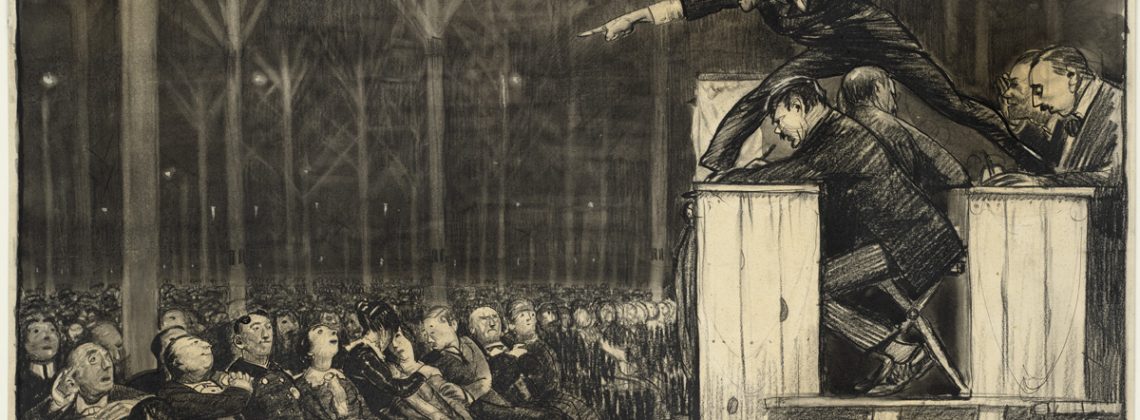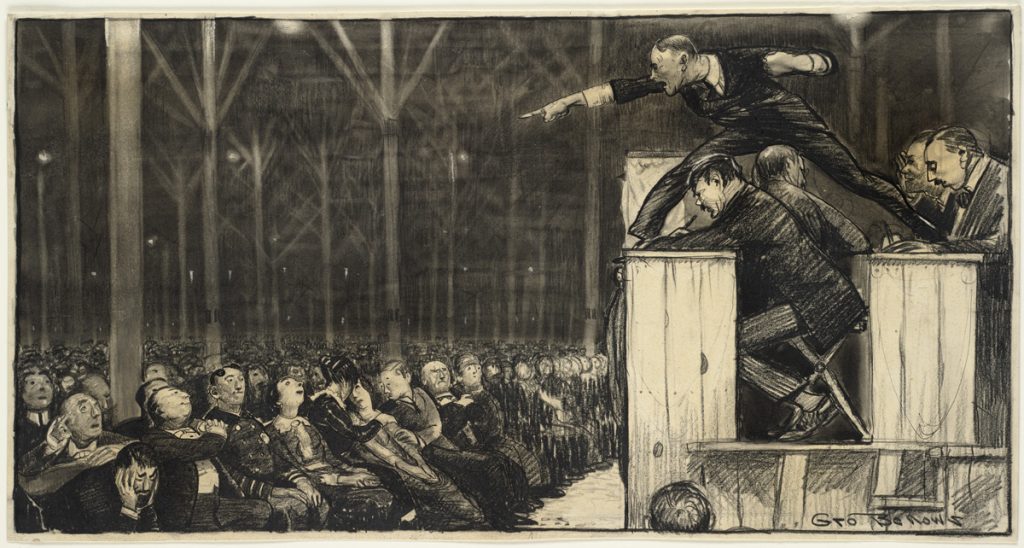

Those invested in this project engage in an impossible task
I often tell my students that if they want to play a role in shaping the contours of American evangelical Christianity they should study history. While the work of biblical scholars and theologians might influence what is said from pulpits on Sunday mornings, and journalists, sociologists, and religious studies scholars do a good job of explaining evangelicalism to unbelievers, in the past forty years historians have done more to define this movement than the practitioners of any other intellectual discipline.
For example, in the 1980s and 1990s historians Mark Noll and George Marsden taught us how evangelicalism has always been tangled-up, often in unhealthy ways, with American nationalism. They showed us how the evangelical embrace of early modern ideas such as Baconian induction and Common Sense Realism influenced the movement’s views on eschatology (dispensationalism) and biblical authority (inerrancy). Donald Dayton and others reminded evangelicals of their roots in the social justice and holiness movements of the nineteenth century. And British historian David Bebbington’s so-called “Bebbington Quadrilateral” (biblicism, crucicentrism, conversionism, and activism) remains the standard definition of the movement in the evangelical community.
These scholars wrote sweeping accounts of the history of evangelicalism, framing the conversation surrounding the historical definition of the movement for decades to come. They were, and still are, giants in the field whose work historians must continue to reckon with, in the same way the ghost of Perry Miller still hovers over the study of Puritan New England, or Gordon Wood’s byline in the New York Review of Books still gets historians of the American Revolution hot under the collar. Because these historians of American evangelicalism wrote such paradigm-shifting works, the next generation of scholars has spent their careers writing books and articles focused on bringing greater nuance and diversity to these magisterial narratives.
Let me try to shed light on the work of this second generation of scholars through a recent Twitter thread initiated by University of Chicago historian Kathleen Belew. In her attempt to explain to her students how different historical methodologies inform our understanding of the past, Belew asked historians on Twitter how they would approach the classic question: “Why did the chicken cross the road?” from the perspective of their historical subfields. Belew got the ball rolling by suggesting that a social historian “wants to know not about the chicken that crossed the road, but the chickens that lived in the community that gave rise to the chicken that crossed the road such that we have a better understanding how the crossing was a collective action.” Or perhaps, she suggested, an old school political historian might write a “biography of what made this a “Great Chicken.”
Twitter historians jumped at the chance to participate in Belew’s exercise. A legal historian wanted to know “what kinds of laws govern the crossing, how those who are denied the ability to cross pursue legal action, and whether the laws in place are representative of the norms chickens follow in crossing the road.” Someone suggested that a historian of gender would “want to know why the term ‘chicken’ is usually culturally assumed to mean ‘hen.’” An oral historian said she would seek out those who remembered observing the chicken crossing the road so that she could examine “the factors which led to the creation of the narrative.” A historian of childhood wanted to “know the importance of road crossing as an element of the socialization of chicks.” And so on. Indeed, there are many ways to explore and interpret why the chicken crossed the road.
Today, as more and more historians approach the history of American evangelicalism from the methodological commitment of their chosen subfields, we are left with a glorious mess. Our current understanding of the movement defies any kind of meaningful synthesis. To claim that there is one definition of evangelicalism requires us to ignore the last generation or two of historical scholarship.
For example, intellectual historians such as Noll, Matthew Sutton, Randall Stephens and Karl Giberson, and Molly Worthen see evangelicalism as an anti-intellectual movement lacking the kind of eccelsiastical authority necessary to carry it through times of crisis. Gender historians (Margaret Bendrorth, Betty DeBerg, Kristin Kobes Du Mez) view evangelicalism as a movement defined by patriarchy and “toxic masculinity.” Anthea Butler, Jesse Curtis, Rusty Hawkins, and Jemar Tisby see a movement defined by white supremacy, while Randall Balmer, Darren Dochuk, David Swartz, and Daniel K. Williams portray evangelicalism as a coalition of Christians in search of political power for the purpose of restoring America to its supposed Judeo-Christian roots.
There are others who explain evangelicalism through the lens of nostalgia and memory (John Fea, Laura Kerby, Devin Manzullo-Thomas), capitalism (Darren Dochuk, Darren Grem, Daniel Vaca, Timothy Gloege, and Bethany Moreton), and, of course, religious belief (Bebbington,Thomas Kidd, and, to an extent, John Stackhouse come immediately to mind). Historians of foreign policy, diplomacy, and global history such as Lauren Turek, Heather Curtis, and Dana Robert write about a movement defined by evangelism, missions, and humanitarianism.
When taken together, these works provide us with a historiography that reveals evangelicalism’s multi-dimensional character and fills in gaps left in the narratives of Noll, Marsden, Dayton, and Bebbington.
We know so much about American evangelicalism today that claims such as “you thought evangelicalism was THIS, but it is really THIS” lack historical integrity. To take this point a step further, the scholarship of this movement has matured to such an extent that efforts to define white evangelicalism historically seem like a waste of time and energy. It’s time to bring back Timothy L. Smith’s “kaleidoscope” and Balmer’s “patchwork quilt” and just leave it at that.
If it appears from your online reading that a particular definition of evangelicalism has claimed the interpretive high ground, it probably has less to do with whether or not that historian offers a nuanced and full treatment of evangelicalism and more to do with the size of his or her publicity team, publisher, or social media platform.
John Fea is Executive Editor of Current.
Wonderful meditation by the great and good Professor John Fea, as ever – I particularly enjoyed the chicken section. I sympathize with the basic thrust of this piece – indeed there is a interesting parallel piece currently over at _Marginalia Review of Books_ which emphasizes that “religion” cannot be defined either. Two reflections:
1) I am currently teaching Historiography and one of the textbooks is Ulinka Rublack (ed.), _A Concise Companion to History_ (Oxford U. Press), which has a common thrust and its chapters that historians should not be doing nationally cropped studies anymore but see their theme in an international context. The “evangelical” conversation by American historians, however, seems to always speak of evangelicalism as a self-contained American movement and not even consider that American evangelicals are in relationship with self-identified evangelicals around the world and what the implications of that are for their sense of what “evangelicalism” or the evangelical movement is.
2) Those who have been eschewing any definition seem to just be arguing that one start studying people and find out what actually motivates them (Daniel Silliman in the current issue of _Church History_ with his case study on _Christianity Today_). I wonder, however, how one decides what people to start with as a case study and if one builds out from there does that not then make them the normative evangelicals, the very thing one supposedly wanted to discover rather than presume to already know?
Hi Timothy. On your first point. I wonder how those trying to complicate the historical narrative of evangelicalism explain the movement to students. Do they say that white evangelicalism, for example, is not a belief system but a movement of racism, patriarchy, middle class capitalism, or Christian nationalists who parade under the guise of religious belief? Moreover, so many of these historians are religious historians. A some point in their careers they have probably tried to get students to see religion on its own terms, rather than saying that religion is always a cover for something else (racism, patriarchy, power, bourgeois values, etc.). Of course that when you start defining evangelical Christianity in a global context it changes the conversation. On the second point–I agree. I think that was the point of my piece. Each subfield brings their own methodology and that, in turn, shapes their conclusions. This, as you know, happens all fields of historical inquiry. Look at the debates over the definition of the “American Revolution” or the “Progressive Era.” Thanks for the comment!